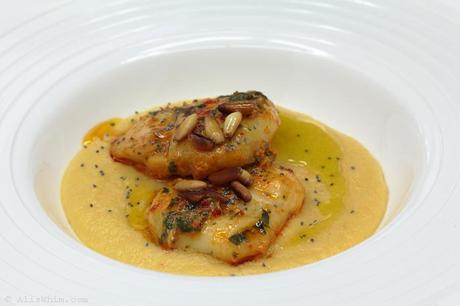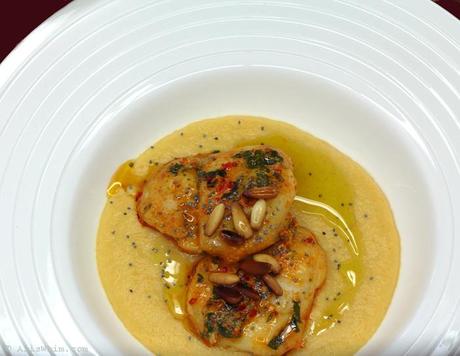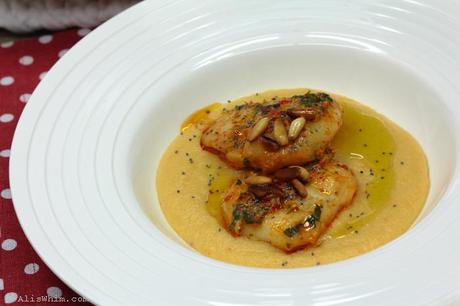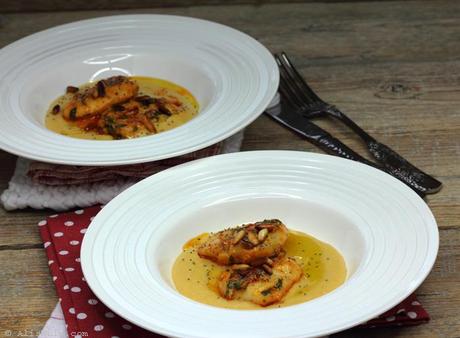Monkfish cheeks with Espelette pepper and cream of Jerusalem artichoke




Este es uno de los platos más deliciosos que he cocinado estas últimas semanas. Las cocochas toman un sabor intenso y algo picante gracias al puré de pimiento de Espelette, la crema de topinambur con zanahorias y crema de coco queda sabrosa y el ligero dulzor acompaña muy bien este pescado. Es un plato delicado de ingredientes diferentes, parece gourmet pero no resulta demasiado caro y, además, es muy fácil de hacer.
This is one of the most delicious dishes I’ve cooked in the last few weeks. The monkfish cheeks take an intense flavor slightly spicy with the Espelette pepper purée, the cream of Jerusalem artichoke with carrots and coconut cream is very tasty; and the slight sweetness nicely accompanies this spicy fish. It is a delicate dish of different ingredients, looks gourmet but is not very expensive and also very easy to do.
Receta
Ingredientes:
(Para dos personas)
- 400 gr de cocochas de rape
Crema de pimiento de Espelette
Perejil
Sal y pimienta
Una cucharada sopera de semillas de amapola
Un puñado de piñones de pino
Una zanahoria
250 gr de topinambur
100 ml de leche de coco
1/2 pastilla de caldo concentrado de verduras bio
Preparación:
- Retirar la piel a las cocochas y las posibles espinas. Extenderlas en un plato y salpimentar por ambos lados. Recuerda que comer mucha sal puede conllevar un aumento de la tensión arterial.
- Para la crema de raíces: pelar y lavar el topinambur y la zanahoria. Trocear y poner a hervir los trozos en una cazuela con agua, unos 500 ml. Calentar a fuego fuerte y, cuando rompa a hervir, bajar a fuego medio. Añadir media pastilla de caldo vegetal concentrado bio y un chorrito de aceite de oliva virgen extra. Cubrir la cazuela y hervir a fuego medio hasta que las dos raíces estén bien tiernas (de 20 a 25 minutos).
- Retirar los trozos de topinambur y de zanahoria e introducirlos en un bol, triturar con la batidora añadiendo algo de caldo de la cocción. Agregar el caldo suficiente para obtener una textura tipo puré. Añadir 100 ml de leche de coco y volver a mezclar con la batidora hasta obtener una textura cremosa. El pescado tendrá un sabor intenso, es mejor que la crema no esté salada para compensar.
- Dorar unos piñones en una sartén con un cucharadita de aceite y una pizca de sal. Retirar y reservar.
- En una sartén de un tamaño suficiente para que quepan todas las cocochas bien extendidas se añade un chorrito de aceite de oliva. Se pone el fuego fuerte, se añaden las cocochas y se baja a fuego medio. Las cocochas soltarán líquido. Agitar de vez en cuando las cocochas, el jugo que suelten se mezclará con el aceite y creará una especie de salsa.
- A los 5 minutos darles la vuelta con la ayuda de una espátula de madera o similar. Seguir agitando de forma circular la sartén. Cuando empiece a reducir ligeramente el juego, se añade el perejil picado y se pone una pizca de crema de pimiento de Espelette en cada cococha. Se les vuelve a dar la vuelta. Poco a poco se irá reduciendo el jugo y las cocochas irán tomando un bonito color dorado rojizo. Ya están listas.
- Servir en un plato hondo, con la crema de raíces al fondo, dos o tres cocochas encima. Espolvorear de semillas de amapola, unos piñones y un chorrito de aceite de oliva virgen extra.
¡Está buenísimo!
Recipe
Ingredients:
(For two persons)
- 400 g monkfish cheeks
Espelette pepper cream
Parsley
Salt and pepper
One tablespoon of poppy seeds
A handful of pine nuts pine
A carrot
Topinambur 250g
100 ml of coconut milk
1/2 tablet of bio vegetable bouillon
Directions:
- Remove the skin and any bones from the monkfish cheeks. Spread them on a plate and season on both sides. Remember that too much salt can lead to high blood pressure.
- For the cream of roots: Peel and wash the Jerusalem artichoke and the carrot. Chop and boil the pieces in a pot with water, about 500 ml. Start heating high and when it starts boiling, lower heat to medium. Add half vegetable broth concentrate bio and a drizzle of extra virgin olive oil. Cover the pan and simmer over medium heat until the two roots are tender (20 to 25 minutes).
- Remove the pieces of Jerusalem artichoke and the carrot and place in a bowl, blend adding some cooking broth. Add broth sufficient to obtain a puree-like texture. Add 100 ml of coconut milk and mix again with mixer until smooth. Add more broth if the texture is too thick. The fish will have an intense flavor then it is better a cream not too salty to equilibrate.
- Fry some pine nuts in a skillet with a teaspoon of oil and a pinch of salt. Remove and set aside.
- In a skillet large enough to fit the monkfish cheeks well spread, add a splash of olive oil around three tablespoon. Start with high heat, add the cheeks and low to medium heat. The cheeks will release liquid. Stir occasionally, the cheeks juice will be mixed with the oil and produce a sort of sauce.
- After 5 minutes, turn the cheeks with the aid of a wooden spatula or similar. Continue stirring the skillet in a circular way. When you see the sauce is slightly reduced, add chopped parsley and put a pinch of Espelette pepper cream in every cheek piece. They do get around. The juice will be gradually reduced and the monkfish cheeks will take a nice golden color red. They are ready.
- Serve in a bowl or dish with the cream of roots at the bottom, two or three cheeks over. Sprinkle with poppy seeds and pinions and a drizzle of extra virgin olive oil.
It’s great!

